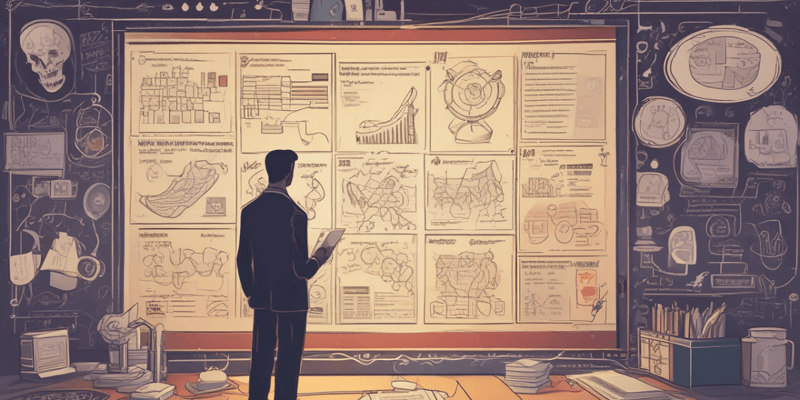Podcast
Questions and Answers
What is the first step a hotel manager should take when addressing customer complaints?
What is the first step a hotel manager should take when addressing customer complaints?
After selecting the best alternative, what is the next step the hotel manager should take?
After selecting the best alternative, what is the next step the hotel manager should take?
Which of the following is an example of evaluating alternatives in decision making?
Which of the following is an example of evaluating alternatives in decision making?
What is the purpose of following up and evaluating the effects of the chosen alternative?
What is the purpose of following up and evaluating the effects of the chosen alternative?
Signup and view all the answers
Which aspect differentiates leadership from management in a business context?
Which aspect differentiates leadership from management in a business context?
Signup and view all the answers
What is the primary focus of the Trait Approach to Leadership?
What is the primary focus of the Trait Approach to Leadership?
Signup and view all the answers
Which of the following behaviors is associated with Task-Focused Leader Behavior?
Which of the following behaviors is associated with Task-Focused Leader Behavior?
Signup and view all the answers
What is a key characteristic of Transformational Leadership?
What is a key characteristic of Transformational Leadership?
Signup and view all the answers
How does the Behavioral Approach to Leadership differ from the Trait Approach?
How does the Behavioral Approach to Leadership differ from the Trait Approach?
Signup and view all the answers
Which leadership style is often considered inferior to transformational leadership?
Which leadership style is often considered inferior to transformational leadership?
Signup and view all the answers
What is a common element of both Task-Focused and Employee-Focused Leader Behaviors?
What is a common element of both Task-Focused and Employee-Focused Leader Behaviors?
Signup and view all the answers
What does the term 'transformational leadership' specifically address?
What does the term 'transformational leadership' specifically address?
Signup and view all the answers
What aspect of leadership do leaders prioritize in Employee-Focused Behavior?
What aspect of leadership do leaders prioritize in Employee-Focused Behavior?
Signup and view all the answers
What is the primary distinction between leadership and management?
What is the primary distinction between leadership and management?
Signup and view all the answers
Which of the following types of power is based on the authority granted through organizational hierarchy?
Which of the following types of power is based on the authority granted through organizational hierarchy?
Signup and view all the answers
How does coercive power operate in a leadership context?
How does coercive power operate in a leadership context?
Signup and view all the answers
What aspect does transformational leadership emphasize?
What aspect does transformational leadership emphasize?
Signup and view all the answers
What is a key characteristic of transactional leadership?
What is a key characteristic of transactional leadership?
Signup and view all the answers
Which leadership approach is characterized by a dependency on rewards and punishments?
Which leadership approach is characterized by a dependency on rewards and punishments?
Signup and view all the answers
In which scenario is transactional leadership most likely to be effective?
In which scenario is transactional leadership most likely to be effective?
Signup and view all the answers
What role do leadership substitutes play in an organization?
What role do leadership substitutes play in an organization?
Signup and view all the answers
Which power type derives from a leader's specific knowledge or skill?
Which power type derives from a leader's specific knowledge or skill?
Signup and view all the answers
What is meant by 'leadership substitutes'?
What is meant by 'leadership substitutes'?
Signup and view all the answers
Which of the following is an example of leadership neutralizers?
Which of the following is an example of leadership neutralizers?
Signup and view all the answers
In what way do gender and cross-cultural issues impact leadership?
In what way do gender and cross-cultural issues impact leadership?
Signup and view all the answers
How do intrinsic motivation and leadership interact?
How do intrinsic motivation and leadership interact?
Signup and view all the answers
What are the differences often misunderstood about gender and leadership?
What are the differences often misunderstood about gender and leadership?
Signup and view all the answers
What is a common pitfall of transactional leaders?
What is a common pitfall of transactional leaders?
Signup and view all the answers
What role do organizational constraints play in leadership effectiveness?
What role do organizational constraints play in leadership effectiveness?
Signup and view all the answers
What tends to be the decision-making style of females compared to males?
What tends to be the decision-making style of females compared to males?
Signup and view all the answers
Which of the following best defines a programmed decision?
Which of the following best defines a programmed decision?
Signup and view all the answers
In which state does a decision maker know the alternatives available and their associated conditions?
In which state does a decision maker know the alternatives available and their associated conditions?
Signup and view all the answers
What is the first step in the rational decision-making process?
What is the first step in the rational decision-making process?
Signup and view all the answers
Which of the following decisions is considered nonprogrammed?
Which of the following decisions is considered nonprogrammed?
Signup and view all the answers
What occurs during the state of uncertainty in decision-making?
What occurs during the state of uncertainty in decision-making?
Signup and view all the answers
What is meant by the term 'decision-making process'?
What is meant by the term 'decision-making process'?
Signup and view all the answers
Which of the following is a characteristic of the state of risk in decision-making?
Which of the following is a characteristic of the state of risk in decision-making?
Signup and view all the answers
Study Notes
Chapter 9: Leadership and Decision Making
- Leadership: The processes and behaviors used by someone, like a manager, to motivate, inspire, and influence the actions of others.
Learning Objectives
- Define leadership and differentiate it from management.
- Summarize early approaches to leadership study.
- Detail transformational, transactional, and charismatic leadership perspectives.
- Identify and discuss leadership substitutes and neutralizers.
- Analyze leaders as coaches, examining gender and cross-cultural issues in leadership.
- Relate leadership to decision-making, discussing both rational and behavioral aspects.
The Nature of Leadership
- Leadership involves the processes and behaviors used to motivate, inspire, and influence the actions of others.
Leadership and Power (1 of 2)
- Power: The ability to influence the behavior of others.
- Legitimate Power: Power derived from organizational hierarchy.
- Reward Power: The ability to give or remove rewards.
- Coercive Power: The ability to enforce compliance through psychological, emotional, or physical threat.
Leadership and Power (2 of 2)
- Referent Power: Power based on personal traits or charisma, leading to employee loyalty and acceptance of organizational changes.
- Expert Power: Power derived from knowledge or expertise.
Early Approaches to Leadership (1 of 2)
- Trait Approach: Focuses on identifying the essential traits distinguishing leaders. Traits include intelligence, dominance, self-confidence, energy, activity, and job knowledge.
Early Approaches to Leadership (2 of 2)
- Behavioral Approach: Examines the behaviors leaders employ. It focuses on observable actions rather than personality, including setting goals, giving feedback, and emphasizing teamwork.
Behavioral Approach to Leadership
- Task-Focused Leader Behavior: Focuses on how tasks should be performed to achieve goals and meet performance standards.
- Employee-Focused Leader Behavior: Focuses on employee satisfaction, motivation, and well-being.
Leadership Through the Eyes of the Followers (1 of 3)
- Transformational Leadership: A style that alters people, situations, and organizational culture. It enhances motivation, emotions, values, ethics, and long-term goals through diverse mechanisms. These mechanisms include connecting followers' identities to the organization's, serving as a role model, challenging followers to take ownership, and understanding their strengths and weaknesses.
Leadership Through the Eyes of the Followers (2 of 3)
- Transactional Leadership: The most frequent leadership style, sometimes viewed as less effective than transformational leadership. It leverages reward and punishment to achieve compliance from followers. It prioritizes maintaining the status quo, unlike transformational leadership.
Special Issues in Leadership (1)
- Leadership Substitutes: Individual, task-related, or organizational characteristics that negate the need for direct leadership intervention. Examples include highly skilled and self-motivated team members, and intrinsic motivation.
Special Issues in Leadership (2)
- Leadership Neutralizers: Factors that hinder the effectiveness of leadership behaviors. Examples include organizational constraints (like limited resources), employee resistance to authority, and external factors (like market conditions).
The Changing Nature of Leadership (1 of 2)
- Leaders as Coaches: Leaders move from being directive overseers to mentors.
- Gender and Leadership: Challenges stereotypes; women aren't necessarily more nurturing and men aren't necessarily more controlling than women. Women tend to be more democratic, while men may be more autocratic.
The Changing Nature of Leadership (2 of 2)
- Cross-Cultural Leadership: The impact of an individual's native culture on leadership style when working in different cultural settings.
Decision Making
- Decision Making: Choosing from several options.
- Decision-Making Process: Recognizing the decision situation, identifying alternatives, selecting the best alternative, implementing it, and evaluating the results.
Types of Decisions
- Programmed Decisions: Recurring, structured decisions (e.g., employee scheduling).
- Non-programmed Decisions: Unstructured, infrequent decisions (e.g., responses to changing economic conditions).
Decision-Making Conditions (1 of 2)
- State of Certainty: Decision-makers know the alternatives and their associated conditions.
- State of Risk: Probability estimates are used for alternative outcomes and their costs.
Decision-Making Conditions (2 of 2)
- State of Uncertainty: Alternatives, probabilities, and consequences are unknown.
Rational Decision Making (1 of 3)
- Steps in rational decision making:
- Recognizing/defining the decision situation
- Identifying alternatives
- Evaluating alternatives
- Selecting the best alternative
- Implementing the chosen alternative
- Following up and evaluating results
Rational Decision Making (2 of 3)
- Detailed steps of rational decision making, using a hotel manager example.
Rational Decision Making (3 of 3)
- Continuing the rational decision-making steps, using a hotel manager example to illustrate each step.
Applying What You've Learned (1 of 2)
- Review of major concepts covered in the chapter.
Applying What You've Learned (2 of 2)
- Continuation of the key concepts covered in the chapter.
Studying That Suits You
Use AI to generate personalized quizzes and flashcards to suit your learning preferences.
Related Documents
Description
Explore the key concepts of leadership as discussed in Chapter 9. This quiz covers definitions, different leadership styles, and their relationship to decision-making. Delve into topics like transformational leadership, power dynamics, and the role of culture in leadership effectiveness.




